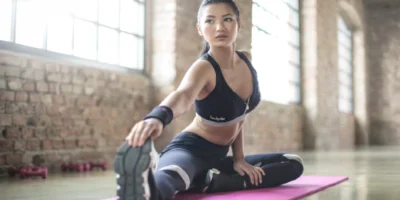A detailed guide on how to kick a soccer ball that outlines how feet, legs and the body should be positioned, the best approach to practice, and how to kick corners like a pro.
Find more sport and health guides, tips and advice
Physical analysis
This area of analyzing a shot (the kick) in the field of football only includes the external aspect of the shot, ie any thinking, learning or imagining processes are initially left out of sight. So you can imagine that this represents the first stage in the learning process and is therefore as easy as possible for the athlete.
Using the concrete example of soccer, the analysis looks like this: First of all, a shot is shown in the most perfect execution possible, so that the beginner already has a picture of the overall movement, then the first learning steps begin.
How to kick a soccer ball: Positioning
First of all, the movement is carried out very slowly, accompanied by explanatory words and without a ball, ie dry, so that the learner can see exactly what he has to pay attention to and how it should look. See the examples in the video below.
How to kick a soccer ball: Position of the foot
When shooting, it is now important that the tip of the foot points towards the ground, the knee must be slightly bent, otherwise the tip of the foot would hit the ground.
How to kick a soccer ball: Position of the body
The upper body must be bent forward so that the ball does not fly too high provided you want to shoot the ball flat.
How to kick a soccer ball: Position of the supporting leg
The supporting leg must not be too far from the ball, otherwise the shooting leg will not be in the right position to hit the ball optimally.
In addition, the body and above all the kicking leg must be put into tension so that the foot does not “slither around” and there is no force in the shot.
How to kick a soccer ball: Practicing the movement
Now let the beginner do the movement and help him with improvements that are kept as simple as possible, as he will not be able to correct his own mistakes at the beginning. For this purpose, for example, you can slowly move the player’s foot with your hands in order to improve his kinesthetic perception, or take a picture of him with the camera so that he can see his own mistakes.
Performing the movement in front of a mirror is also a positive aspect, as you can see yourself exactly at the point in time of the movement and possibly recognize mistakes more easily, as is also practiced in the gym, for example.
Preparatory / main / and final phase
In this case, pulling out and fixing the ball would be the preparatory phase, i.e. preparing for the shot, followed by the actual execution of the shot (main phase), which ends with leaving the ball, and finally the final phase, in which the body returns is brought into balance and the muscles relax again.
However, one must be very careful with this type of explanation, as the beginner is easily confused and no longer focuses on the essentials. For this reason, we only used variant (1) in our educational film, equipped with different types and designs of the shot.
How to kick a soccer ball: Important features
The backward movement:
The backward swing in a kick plays an important role because it not only determines the power of the shot, but also the precision.
Since the acceleration path is limited, the greatest possible force must be applied to the ball in order to achieve the greatest possible final speed so that the ball flies into the goal as quickly as possible. This can be achieved by the backward movement, which means it serves to lengthen the acceleration path and increase the initial force.
In order to execute the shot precisely and powerfully, the acceleration path must be optimal, ie the backward movement must not be too small or too large.
Principle of counteraction:
A football player uses the principle of counteraction mostly unintentionally, as is the case with other movements. The principle of counteraction can be explained with the principle “action and reaction”.
For example, a player who shoots with his right leg brings his right leg forward with his left arm. This “rotation” and “counter-rotation” creates an optimal backward movement for the optimal shot.
Coordination of partial impulses when shooting
The soccer player pays attention to the coordinated interaction / connection of the shooting leg, arms and trunk. During a shot, the torso is accelerated by the swinging movement of the arms, and then the firing leg is accelerated by the torso and the ball is accelerated by the swinging movement of the shooting leg.
Through these acceleration processes, the various parts of the body are given final speeds. The final speed of the ball is made up of the sum of the partial speeds resulting from the partial impulses . This is only possible if these coincide in time, merge into one another and thus add up.
Impulse transmission
When the acceleration processes and the final speed of the individual body parts are added up and transmitted to the ball, one speaks of impulse transmission. As already mentioned, this is only possible if the partial speeds coincide in time.
Determination of learning-relevant aspects
In soccer development, the aspects with which one learns the shot are very important, but they have less to do with the shot itself, as one also has to pay attention to the posture, stance, etc. when shooting.
Aspects relevant to learning when shooting are good ball control and body control, but as already mentioned, these aspects have less to do with the shot itself. To learn how to get in touch with the ball, you can run around a couple of cones in slalom, for example.
However, one can learn the different types of shots, such as instep, inside, long-range, etc. With a good instep, the correct posture must be learned. When you shoot you shouldn’t bend your body backwards, as many beginners do wrong, but forwards to avoid an uncontrolled shot.
How to kick corners like a pro
Many people swear by the importance of corners in football. They believe this is one of the best ways to score. The strategy is simple: move a great defender forward and watch them head in the ball. In practice, however, this is usually not that easy. In a professional soccer game, only 15% of the corners result in a chance and only 8% lead to a goal.
What does that mean now? This means first of all that IF you are a professional footballer and you are able to take a good corner, then you will score an average of 8 goals from 100 corners. That doesn’t sound very profitable. Now imagine that you are not a professional footballer – the percentage is certainly lower, right?
This week I want to take a closer look at how you can get better at corners and thus increase your chances of finding the head of Per Mertesacker on his team. JayMike also recently released a great video that explores exactly this topic. So if you’re ready to take corners like Toni Kroos, you’ve come to the right place.
Pulled towards
If you want to play the ball pulled towards the goal , then you should take the corner from the other side of the court like your strong foot. So you can turn the corner towards the gate. The technique is very similar to that of a free kick. In summary, you need to position your foot so that your toes are pointing towards the penalty area line – this is how you can give the ball the spin it needs. You also have to make sure that you hit the ball a bit to the side and more on the lower part. According to scientific reports, this type of corner is statistically the most effective for creating scoring opportunities – especially if you want to play your teammate on the first post.
Stepped away from the gate
In that case, you’d kick the corner off the side where your strong foot is. The trajectory of the ball moves away from the goal – and thus also away from the goalkeeper. The shooting technique is the same as in the variant in which you shoot the ball in the direction of the goal, unless your target is the penalty spot. This is great when you want to get the ball onto the second post. If your attacker gets through to the second post, you can create a lot of danger in the opposing penalty area.
Top spin
This technique requires a lot of training, but once you master it, you can use it to surprise your opponent and create some scoring opportunities. The technique is very similar to the previous one, but you have to hit the ball a little higher and with more force. This gives the ball a greater speed and it drops unpredictably in the penalty area. A real nightmare for any defender. You should take a look at Christian Eriksen doing his corners if you want to see the perfect execution.
Drop ball
We recommend you only use this variant if the opposing goalkeeper and the defense are rather smaller. Otherwise this tactic is too easy to defend. The idea behind this technique is to play the ball with a backspin and hit the corner very flat into the penalty area. The ball has a relatively long flight time, which gives your attackers enough time to get into the best position. However, you must not forget that it also gives the opposing team more time to defend the corner. A good, tall goalkeeper should usually be able to catch this ball with ease, every time.
In general, my advice for all of the above techniques is that practice makes perfect. It is best to practice alone as well as with your teammates. In the end, two factors are needed for a goal: 1. a good corner kick that lands exactly on the attacker’s head and 2. the attacker must of course also know where to expect the ball. So, what are you waiting for? Get out on the pitch and train!
So those were the tips on how to improve your corners. I hope some of the ideas have been helpful and you can apply them to the next game. Maybe your team will score more goals from corners in the future ..




